
Oskar, the main character of Günter Grass’s 1958 novel, The Tin Drum, is a shrieking child anarchist who deliberately stops his biological growth at the age of three. He is observant and impetuous, sneering at the behavior of adults around him. The boy Oskar also makes an appearance in the scientific field of population ecology, where he is used as a namesake term for trees that “prefer the juvenile to the adult state.” These nonhuman Oskars occupy the understory of a mature forest, where seeds have germinated and grown up into shade-tolerant saplings, but persist as “ageing juveniles, lingering in a stunted condition” for decades (Figure 1). These individuals grow imperceptibly in diameter and height as they wait for mature trees to die and create an opening in the canopy. Once such a gap appears, the Oskars grow quickly toward the light, and advance to the next stage of biological development. While it is risky to anthropomorphize the landscape, in this case humans share a common attribute of growth: maturity is not strictly related to chronological age.
Continue Reading:






